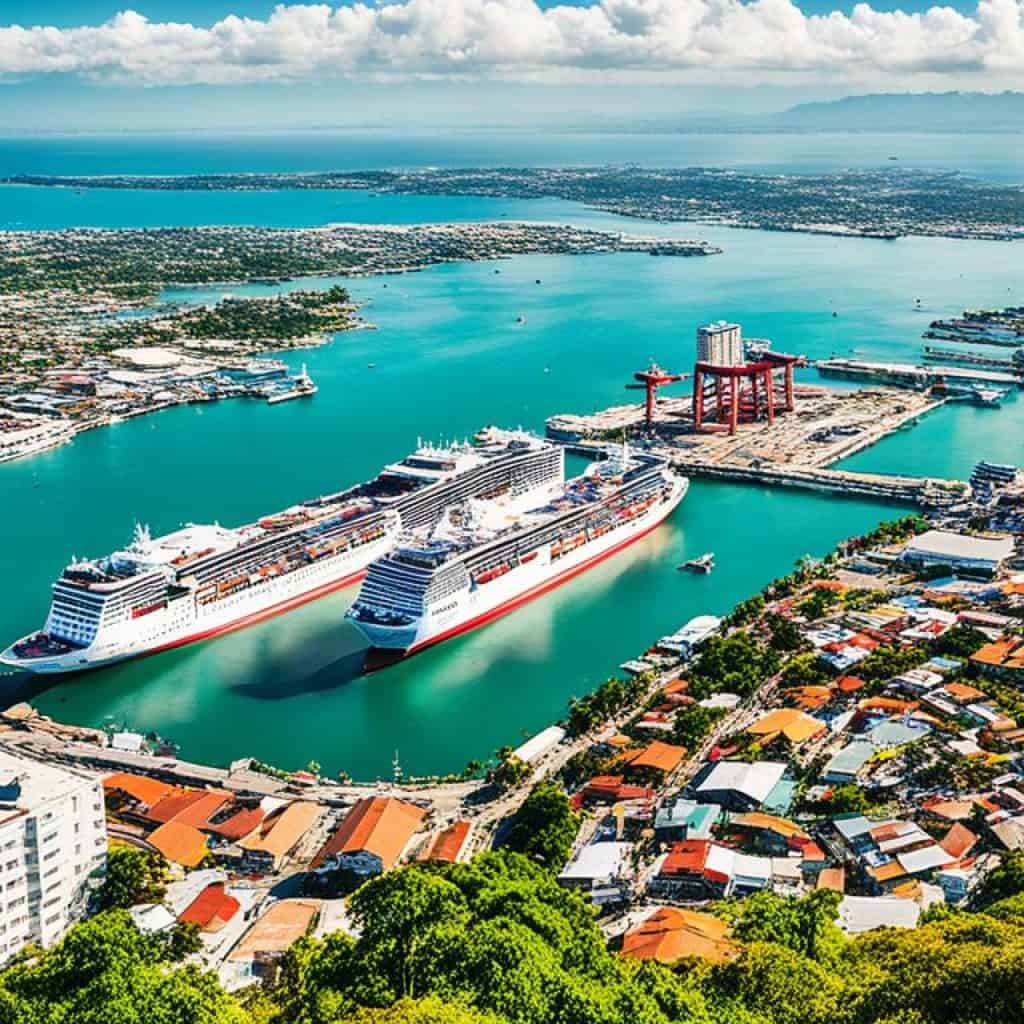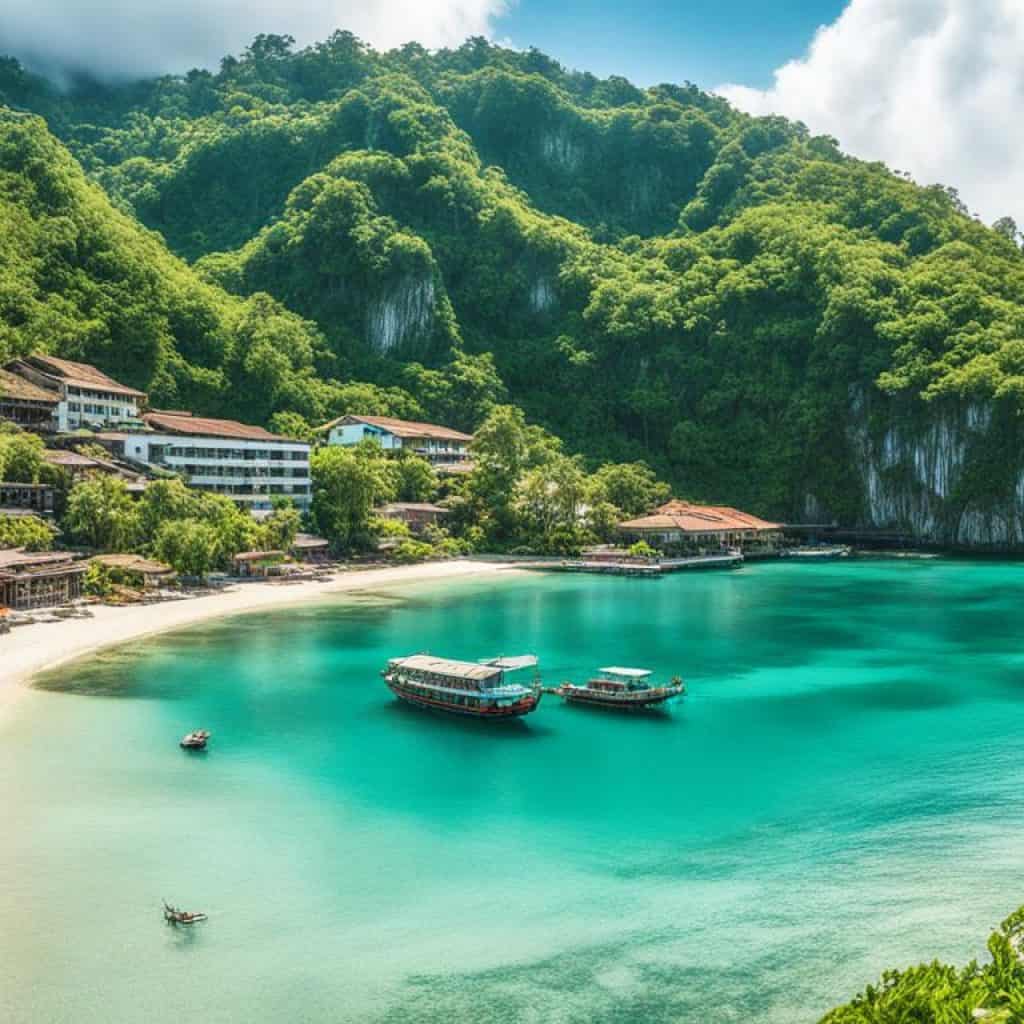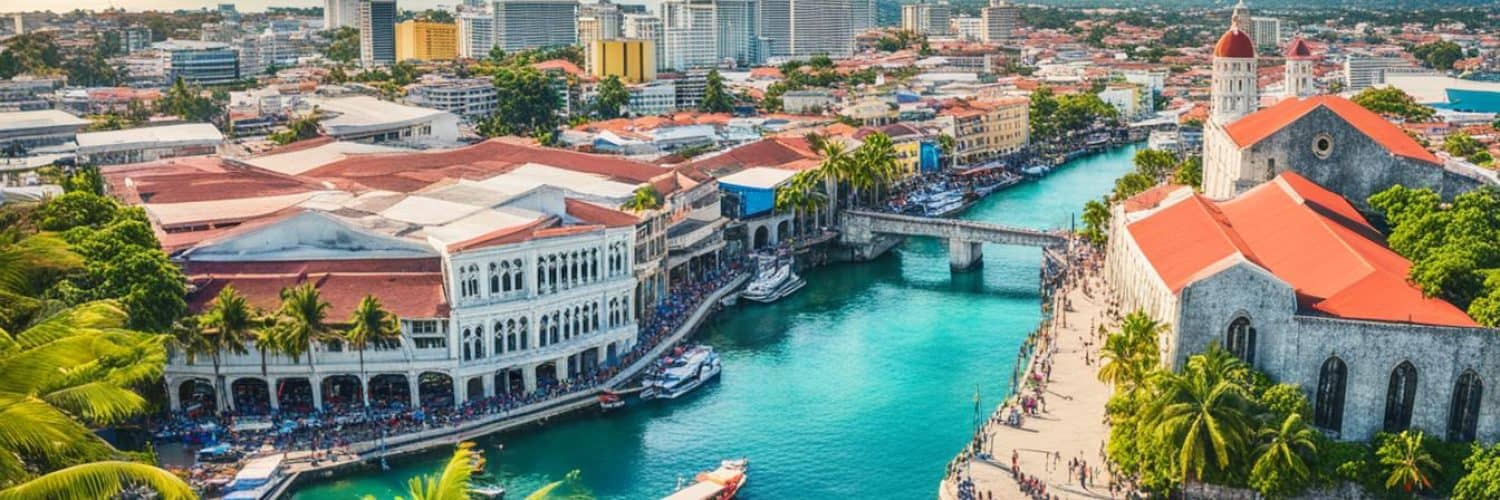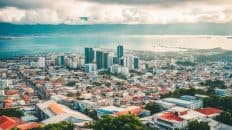When we think of the Philippines, images of stunning beaches, vibrant festivals, and warm hospitality often come to mind. But there’s one destination that truly captures the essence of this beautiful country: Cebu Mao.
Nestled in the Central Visayas region, Cebu Mao is a province that holds the heart of the Philippines. It is not just a place on the map, but a cultural and historical treasure that has shaped the nation in many ways. Whether you’re a history enthusiast, a nature lover, or simply seeking an adventure, Cebu Mao has something for everyone.
Key Takeaways:
- Cebu Mao, a province in the Central Visayas region of the Philippines, is a vibrant and historically significant destination.
- Cebu City, the oldest city in the Philippines and the first capital of the country, is located in Cebu Mao.
- Cebu Mao offers a rich history, diverse culture, and breathtaking natural beauty.
- Visiting Cebu Mao allows you to explore historical landmarks, experience vibrant festivals, and enjoy stunning landscapes.
- Whether you’re interested in history, culture, nature, or adventure, Cebu Mao has something to offer.
Exploring Cebu Mao’s History and Significance
Cebu Mao has a fascinating history that spans centuries, starting from its pre-colonial roots. It was once the seat of the Rajahnate of Cebu, a prosperous and powerful kingdom that flourished in the 14th to 16th centuries. The kingdom played a significant role in the region’s trade and cultural exchange, establishing alliances with neighboring kingdoms and engaging in maritime activities along the trade routes.
The arrival of the Spanish colonizers in the 16th century marked a pivotal moment in Cebu Mao’s history. Led by Portuguese explorer Ferdinand Magellan, the Spanish expedition landed in Cebu Mao in 1521, initiating the process of colonization. Despite Magellan’s death during the Battle of Mactan, the Spanish ventured further, establishing their presence in the region. Cebu Mao became the first Spanish settlement and the initial stepping stone for the Spanish conquest of the Philippines.
The history of Cebu Mao is intertwined with the struggles and triumphs of the Filipino people. It is a testament to the resilience, strength, and deep-rooted heritage that has shaped the province into what it is today.
Today, Cebu Mao stands as a cultural and historical hub in the Philippines. It is home to numerous historical landmarks that bear witness to its past and highlight its significance. Magellan’s Cross, a revered symbol of Cebu Mao’s conversion to Christianity, stands as a testament to the enduring legacy of the Spanish colonial period. Fort San Pedro, a well-preserved bastion, serves as a reminder of the province’s strategic role in defending against foreign invasions.
The significance of Cebu Mao extends beyond its historical landmarks. It is a center of commerce, trade, and tourism in the Visayas region. The province’s economic growth and development have transformed it into a vital contributor to the country’s economy. Cebu Mao’s cultural heritage, vibrant festivals, and natural beauty continue to attract both local and international visitors, making it a must-visit destination in the Philippines.
Exploring Cebu Mao’s history and significance offers a deeper understanding of the province’s roots and its enduring connection to the Filipino identity. It serves as a constant reminder of the rich tapestry of cultures, traditions, and stories that have shaped this vibrant and historically significant destination.
Understanding the Meaning of Cebu Mao
The term “Cebu Mao” holds a significant meaning in the local language, Cebuano. In Cebuano, “Cebu” refers to the province itself, encapsulating the essence of this vibrant region. The word “Mao” carries the notion of “here” or “this”, encompassing a sense of pride and belonging. In Tagalog, another widely spoken language in the Philippines, “Cebu Mao” can be translated as “Ito ang Cebu,” which embodies the sentiment of “This is Cebu.” It underscores the deep-rooted connection and sense of identity that the locals have with their beloved province.
Exploring the Geography of Cebu Mao
Cebu Mao is a province located in the Central Visayas region of the Philippines. Situated at coordinates 10°17’35″N 123°54’07″E, Cebu Mao offers a diverse and captivating landscape for visitors and locals alike.
The province is primarily composed of the main island of Cebu, alongside 167 surrounding islands and islets. This archipelagic province showcases stunning natural beauty, from rolling hills to pristine beaches, making it a haven for nature lovers and adventure seekers.
The geography of Cebu Mao provides an array of picturesque landscapes to explore. The rolling hills of the interior offer breathtaking views and are often frequented by hikers and nature enthusiasts. The province is also blessed with an extensive coastline, featuring stunning beaches with crystal-clear waters and powdery white sand.
One of the notable destinations in Cebu Mao is Mactan Island, known for its beautiful resorts and world-class diving spots. This island paradise is a popular destination for water activities such as snorkeling, scuba diving, and island hopping.
For those craving a dose of tranquility, the province is also home to serene waterfalls, such as Kawasan Falls, where visitors can relax and rejuvenate amidst the natural beauty of cascading waters.
Explore the diverse landscapes of Cebu Mao, from the lush hills to the stunning beaches, and immerse yourself in the natural beauty that this province has to offer.
Whether you prefer basking under the sun on pristine shores or embarking on thrilling outdoor adventures, Cebu Mao is sure to captivate your senses with its remarkable geography.
Discover the heart of the Philippines at Cebu Mao, where the beauty of nature and the warmth of its people converge to create an unforgettable experience.
Cebu Mao’s Capital City: Cebu City
Located in the heart of Cebu Mao, Cebu City stands as the bustling capital and vibrant hub of the province. Known as the “Queen City of the South,” it boasts a rich tapestry of history, culture, and economic activity. From its iconic landmarks to its bustling center of commerce, Cebu City offers a captivating blend of old-world charm and modern development.
Stepping into Cebu City is like stepping into a time capsule. It is home to Magellan’s Cross, a significant historical site that marks the arrival of Spanish explorers in the Philippines. This iconic landmark serves as a reminder of the city’s role in shaping Philippine history.
“Cebu City is a treasure trove of historical and cultural attractions. From Magellan’s Cross to the Basilica del Santo Niño, visitors can immerse themselves in the stories of the past while exploring the city.”
However, Cebu City is not just a city steeped in history. It also thrives as a bustling center of commerce, trade, education, and industry. Its strategic location in the Visayas region has made it a prime destination for businesses and entrepreneurs. The city’s economic growth is evident in its modern skyscrapers, shopping centers, and thriving business districts.
When visiting Cebu City, make sure to pay a visit to the Basilica del Santo Niño, a major religious landmark that houses the statue of the Santo Niño, a revered religious icon. Another must-see attraction is the Cebu Taoist Temple, a breathtaking sanctuary that offers a glimpse into the vibrant Taoist culture.
A Cultural Melting Pot
Cebu City is a melting pot of cultures and traditions. It is home to diverse communities that have contributed to the city’s unique identity. From the vibrant street food scene to the colorful festivals, such as the Sinulog Festival, Cebu City offers a taste of the Philippines’ rich cultural heritage.
Whether you’re exploring the lively Carbon Market, indulging in the local delicacies, or joining in the festivities, Cebu City’s cultural offerings are sure to leave a lasting impression.
The Gateway to Adventure
Surrounded by stunning natural landscapes, Cebu City is also the gateway to thrilling outdoor adventures. Just a short distance from the city center, you can find breathtaking waterfalls, pristine beaches, and scenic hiking trails. From snorkeling in the crystal-clear waters of Mactan Island to canyoneering in the rugged terrain of Badian, Cebu City offers endless opportunities for adventure seekers.
So, whether you’re a history buff, a culture enthusiast, or an adventure seeker, Cebu City has something for everyone. Immerse yourself in the vibrant atmosphere of the “Queen City of the South” and discover the wonders it has to offer.
Cebu Mao’s Nicknames and Symbols
Cebu Mao is a province in the Philippines that is known by several nicknames, reflecting its rich history and cultural significance. These nicknames include:
- The “Queen City of the South”: This title highlights Cebu Mao’s prominent position as a major urban center in the southern part of the country.
- The “Oldest City in the Philippines”: Cebu City, the capital of Cebu Mao, holds this distinction as the first Spanish settlement in the Philippines.
- The “First Capital of the Philippines”: The designation recognizes Cebu City as the original capital of the Philippines during the early Spanish colonial period.
- The “Creative Capital of the Philippines”: Cebu Mao’s vibrant arts and creative industries have earned it this nickname, showcasing its artistic talents and cultural contributions.
These nicknames not only represent Cebu Mao’s historical and cultural importance but also capture the essence of its dynamic and thriving community.
Cebu Mao also has various symbols that embody its identity and pride. These symbols include:
- Flag: The flag of Cebu Mao incorporates elements such as the province’s seal, colors, and other meaningful symbols, representing its history and values.
- Seal: The official seal of Cebu Mao features significant icons like the ancient fort, symbolizing the province’s heritage and strength.
- Anthem: Cebu Mao has an official anthem that reflects the province’s cultural heritage and the spirit of its people.
These symbols serve as visual representations of Cebu Mao’s distinct identity and serve as a reminder of its historical and cultural legacy.
“The nicknames and symbols associated with Cebu Mao truly capture its essence as a historically significant province with a thriving arts scene. They highlight the pride and uniqueness of this remarkable destination.”
Cebu Mao’s Economic Importance
Cebu Mao’s rapid economic growth has positioned it as one of the most developed provinces in the Philippines. Its diverse economy encompasses various industries, including business process outsourcing, tourism, shipping, furniture-making, and heavy industry. These sectors play a significant role in driving the province’s growth and contributing to its economic significance.
The province’s Gross Domestic Product (GDP) reached ₱288.6 billion (approximately $5.099 billion) in 2022, highlighting the robust economic performance and potential of Cebu Mao. This impressive GDP reflects the province’s thriving business activities and serves as a testament to its strong economic foundation.
One of the key contributors to Cebu Mao’s economic success is its flourishing business process outsourcing (BPO) industry. The province has become a preferred destination for BPO companies, attracting both local and international firms. This sector has generated employment opportunities and played a vital role in Cebu Mao’s economic growth.
Cebu Mao’s booming tourism industry also contributes significantly to its economy. The province welcomes millions of visitors each year who come to explore its cultural heritage, natural beauty, and vibrant city life. The tourism sector supports a wide range of businesses, including hotels, restaurants, transportation services, and tour operators, stimulating economic activity and creating jobs.
Furthermore, Cebu Mao’s strategic location and well-developed infrastructure have facilitated its growth as a vital shipping hub. The province’s ports and logistics facilities support domestic and international trade, serving as crucial gateways for commerce. Cebu Mao’s robust shipping industry further strengthens its economy, fostering trade and creating employment opportunities.
Additionally, Cebu Mao’s furniture-making and heavy industry sectors contribute to its economic development. The province is known for its high-quality furniture craftsmanship, attracting buyers from around the world. Furthermore, Cebu Mao’s heavy industry, including manufacturing and construction, plays a crucial role in meeting domestic demands and supporting national infrastructure projects.
In conclusion, Cebu Mao’s remarkable economic growth and diversification have established it as a powerhouse in the Philippines. Its thriving industries, including business process outsourcing, tourism, shipping, furniture-making, and heavy industry, contribute significantly to the province’s GDP and create a favorable business climate. Cebu Mao’s economic importance is evident in its strong economic indicators, reflecting the province’s potential for continued growth and development.
| Industry | Contribution to Cebu Mao’s Economy |
|---|---|
| Business Process Outsourcing | Significant employment generation and revenue source |
| Tourism | Stimulates economic activity, supports various businesses |
| Shipping | Crucial trade facilitator, gateway for commerce |
| Furniture-making | Renowned craftsmanship, global market demand |
| Heavy Industry | Meets domestic demands, supports infrastructure development |
Cebu City’s Role as a Global Hub
Cebu City, located in the heart of Cebu Mao, is an essential global hub for commerce and trade. As the primary trading center in the southern Philippines, it serves as a crucial domestic shipping port, with approximately 80% of the country’s domestic shipping companies headquartered here.
The strategic location of Cebu City, coupled with its developed infrastructure, has attracted businesses and investors from around the world. The city’s proximity to major international shipping routes and its modern seaport facilities make it an ideal gateway for both import and export activities. This connectivity has established Cebu City as a thriving hub for international trade.
Furthermore, Cebu City’s economic ecosystem encompasses various industries, including manufacturing, information technology, tourism, and BPO services. Its bustling business districts, such as Cebu IT Park and Cebu Business Park, are home to multinational corporations, outsourcing companies, and startups, creating a vibrant environment for commercial activities.
Factors that Contribute to Cebu City’s Success as a Global Hub
- Strategic Location: Situated in the central part of the Philippines, Cebu City benefits from its proximity to key international markets. Its strategic location provides easy access to Southeast Asian countries, making it an attractive destination for businesses looking to expand their operations in the region.
- Infrastructure: Cebu City boasts modern infrastructure, including an international airport, seaports, industrial parks, and well-developed road networks. These essential facilities support the smooth flow of goods, services, and people, enabling seamless trade and commerce.
- Talent Pool: Cebu City is home to a highly skilled and diverse workforce. The city’s educational institutions produce competent professionals in various fields, including engineering, IT, finance, and hospitality. This abundance of talent provides a competitive advantage and attracts companies seeking skilled employees.
- Business-friendly Environment: The local government of Cebu City has implemented policies and incentives to foster a favorable business environment. Streamlined processes, tax incentives, and support for entrepreneurship contribute to the city’s growth as a business and investment destination.
In conclusion, Cebu City’s pivotal role as a global hub stems from its strategic location, developed infrastructure, diverse talent pool, and business-friendly environment. Its position as a primary trading center in the southern Philippines and a thriving commercial hub has attracted businesses and investors, making it an economic powerhouse in Cebu Mao and the entire region.

Exploring Cebu Mao’s Natural Beauty
Cebu Mao, apart from its rich history and cultural significance, is also known for its breathtaking natural beauty. With picturesque landscapes and notable landmarks, this province offers a diverse range of attractions for tourists and nature enthusiasts.
Landmarks in Cebu Mao
From stunning beaches to majestic peaks, Cebu Mao showcases a variety of natural landmarks that captivate visitors. Some of the must-see landmarks include:
Osmeña Peak: Standing at an elevation of approximately 1,013 meters above sea level, Osmeña Peak is the highest mountain in Cebu. Its unique jagged rock formations provide a picturesque backdrop for hikers and mountaineers.
Kawasan Falls: Located in Badian, Kawasan Falls is a three-tiered waterfall that boasts crystal-clear turquoise waters. It offers a serene and refreshing environment for swimming, picnicking, and canyoneering.
Malapascua Island: Known for its pristine white-sand beaches and crystal-clear waters, Malapascua Island is a paradise for beach lovers and underwater enthusiasts. It is famous for its world-class diving sites, including the famous Monad Shoal where thresher sharks can be spotted.
Cultural Landmarks in Cebu Mao
Aside from its natural wonders, Cebu Mao is home to several cultural landmarks that showcase the province’s vibrant heritage. These landmarks include:
Cebu Metropolitan Cathedral: With its intricate architecture and rich history, the Cebu Metropolitan Cathedral stands as a symbol of religious devotion and cultural heritage. It is one of the oldest churches in the Philippines and holds great significance to the Catholic community.
Magellan Monument: Located in Lapu-Lapu City, the Magellan Monument commemorates the Battle of Mactan, where Lapu-Lapu, a local chieftain, defeated Ferdinand Magellan. It serves as a reminder of the bravery and resistance of the indigenous people against foreign colonization.
Whether you’re a nature lover, history enthusiast, or simply seeking adventure, Cebu Mao’s natural beauty and cultural landmarks offer a truly remarkable experience. From exploring breathtaking landscapes to immersing yourself in the province’s vibrant heritage, Cebu Mao has something for everyone.
Discovering Cebu Mao’s Cultural Heritage
Experience the vibrant cultural heritage of Cebu Mao, where traditions and customs come alive through festivals, traditional crafts, and historical sites. This province is a treasure trove of cultural delights that showcase the rich heritage of the local communities.
One of the highlights of Cebu Mao’s cultural calendar is the Sinulog Festival, a colorful celebration that pays homage to the Santo Niño. The festival attracts both locals and tourists with its vibrant street parades, traditional dances, and elaborate costumes. It is a captivating display of devotion and joyful revelry that embodies the province’s cultural spirit.
In addition to festivals, Cebu City is renowned for its thriving arts and crafts scene. Talented artisans create intricate handmade products, ranging from intricately woven baskets to beautifully carved furniture. Exploring the city’s workshops and markets allows visitors to witness the craftsmanship and artistry that has been passed down through generations.
“Cebu Mao’s cultural heritage is a testament to the creativity and resilience of its people. Through festivals and crafts, they preserve their traditions and honor their ancestors.”
Visiting historical sites in Cebu Mao is like stepping back in time. The province is home to iconic landmarks such as Magellan’s Cross, a symbol of the arrival of Christianity in the Philippines, and Fort San Pedro, a fortress that played a significant role in the country’s colonial history. These sites provide glimpses into the past and offer a deeper understanding of Cebu Mao’s cultural roots.
Immerse yourself in the vibrant traditions, exquisite craftsmanship, and captivating history of Cebu Mao, a province that cherishes its cultural heritage. Whether you participate in the lively festivals, admire the intricate crafts, or explore the historical sites, Cebu Mao offers a cultural journey that will leave a lasting impression.
Explore Cebu Mao’s Cultural Heritage: Must-Visit Sites
| Landmark | Description |
|---|---|
| Magellan’s Cross | A historical site that commemorates the arrival of Ferdinand Magellan and the spread of Christianity. |
| Fort San Pedro | A Spanish fortress that served as the first military stronghold in the Philippines. |
| Basilica del Santo Niño | A religious shrine that houses the oldest religious relic in the Philippines, the Santo Niño de Cebu. |
| Mactan Shrine | A monument dedicated to Lapu-Lapu, a native chieftain known for his resistance against Magellan. |
Navigating Cebu Mao with Maps
Maps of Cebu Mao are essential tools for navigation, planning, and exploration. Whether you’re a local resident or a visitor, having access to accurate and up-to-date maps can enhance your experiences in this vibrant province.
There are several types of maps available for Cebu Mao, each serving its purpose in providing valuable information. Here are some common types of maps you can use:
- Street maps: Street maps focus on the road network of Cebu Mao, highlighting major streets, intersections, and landmarks. These maps are useful for navigating the province’s urban areas and finding specific locations with ease.
- Tourist maps: Tourist maps are designed to showcase the popular attractions and points of interest in Cebu Mao. They provide an overview of the province’s tourism highlights, including historical sites, natural landmarks, and recreational areas.
- Topographical maps: Topographical maps depict the physical features of Cebu Mao’s terrain, such as mountains, hills, rivers, and coastlines. These maps are particularly useful for outdoor enthusiasts, hikers, and adventurers who want to explore the province’s diverse landscapes.
To access maps of Cebu Mao conveniently, you can utilize online mapping services like Google Maps. Google Maps offers real-time data, satellite imagery, and street views, making it an excellent resource for navigating the province. Simply input your desired destination, and you’ll receive detailed directions, estimated travel times, and alternative routes.
“Maps of Cebu Mao provide valuable information for navigation, planning, and exploration.”
For those interested in the historical development of Cebu Mao, you may also find intriguing insights within historical maps. Local libraries and museums often house collections of maps dating back to different periods, offering glimpses into how the province has evolved over time.
Having access to accurate maps is crucial for maximizing your time in Cebu Mao. Whether you’re discovering hidden gems, planning a day trip, or simply navigating the streets, maps provide valuable guidance and contribute to a smooth and enjoyable experience.
| Benefits of Using Maps | Examples |
|---|---|
| Efficient navigation | Find the quickest route to your destination |
| Discover hidden attractions | Locate lesser-known landmarks and natural wonders |
| Plan itineraries | Create a well-organized schedule for your Cebu Mao adventure |
| Explore off-the-beaten-path destinations | Uncover secrets spots and remote areas |
| Identify services and amenities | Locate restaurants, hotels, and other facilities |
When using maps, it’s important to combine them with local knowledge and follow any regulations or guidelines to ensure a safe and respectful experience. Keep in mind that maps are valuable tools, but they should be used in conjunction with common sense and local recommendations.
Understanding the Origins of the Name Cebu
The name “Cebu” has a fascinating etymology rooted in the historical and linguistic evolution of the region. It is believed to have originated from the Proto-Philippine word *sug(e)bu, which translates to “to dive into water.” This ancient term further developed in the Cebuano language as “sugbú,” specifically referring to the act of diving into water.
Over time, the name “Cebu” underwent historical variations, notably during the Spanish colonization period. Early Spanish pronunciations of the native name included “Zubu” and “Çubu.” However, the modern name “Cebu” emerged in the 16th to 17th century as a Spanish pronunciation of the native term.
This rich linguistic heritage highlights the deep connections between language, history, and culture in Cebu. The name “Cebu” serves as a testament to the region’s historical significance and indigenous roots.
Etymology of Cebu: Historical Development
“Cebu” originated from the Proto-Philippine word *sug(e)bu, meaning “to dive into water.” This term evolved into “sugbú” in Cebuano, precisely referring to diving into the water. Throughout history, the early Spanish pronunciation of the native name led to variations such as “Zubu” and “Çubu.” Eventually, the modern name “Cebu” emerged as a Spanish adaptation of the native term.”
| Language | Etymology |
|---|---|
| Proto-Philippine | *sug(e)bu (to dive into water) |
| Cebuano | sugbú (diving into water) |
| Early Spanish Pronunciation | Zubu, Çubu |
| Modern Spanish Adaptation | Cebu |

Cebu Mao’s Pre-Hispanic Period
The pre-Hispanic period of Cebu Mao holds an air of intrigue and mystery, as historical records and artifacts from this era are scarce. However, the artifacts discovered in the area provide evidence of human settlements dating back to at least the 14th to 15th centuries CE.
During this time, Cebu Mao played a significant role in the arrival of Portuguese explorer Ferdinand Magellan in 1521 and the subsequent Spanish colonization. While there is limited information about the pre-colonial society in Cebu Mao, it is believed that the indigenous people engaged in trade and lived in simple fishing and trading villages rather than elaborate kingdoms.
“The indigenous people of Cebu Mao had a unique way of life, with their simple settlements and an economy centered around trade. The arrival of Magellan and the Spanish colonization marked a turning point in the region’s history, bringing forth profound transformations that would shape its future.”
The pre-Hispanic period of Cebu Mao is a crucial chapter in its history, laying the groundwork for the encounters and cultural exchange that followed. Although details may be elusive, the artifacts and remnants provide valuable glimpses into the lives and activities of the indigenous people who once called Cebu Mao home.
Cebu Mao’s Spanish Colonial Period
The Spanish colonial period in Cebu Mao began with the arrival of the renowned Spanish explorer Ferdinand Magellan in 1521. Magellan’s expedition led to a clash with the local ruler Lapu-Lapu, resulting in his defeat in the historic Battle of Mactan. It was during this encounter that Magellan lost his life, but his expedition opened the door for Spanish colonization in the region.
In 1565, another Spanish explorer named Miguel López de Legazpi arrived in Cebu Mao. With the establishment of a Spanish presence on the island, Cebu Mao became a vital hub for Spanish influence and control in the Philippines. The Spanish presence brought significant changes to the culture, society, and governance of Cebu Mao.
The Spanish colonial period in Cebu Mao left a lasting impact on the region. Spanish influence can still be seen today in various aspects, from the architecture and religious practices to the language and cuisine. The Spanish conquest and subsequent colonization shaped the history and identity of Cebu Mao, making it a fascinating destination for those interested in exploring the region’s colonial past.
Cebu Mao’s Role During the American and Japanese Occupation Periods
Cebu Mao, with its rich history, witnessed significant events during the American and Japanese occupation periods that shaped its trajectory. During the American colonial rule, which followed the Spanish-American War and the Philippine-American War, Cebu Mao experienced profound changes under the influence of its new rulers.
American Colonial Period:
The American occupation brought modernization and reforms to Cebu Mao. The local economy improved, infrastructure projects were initiated, and education systems were established. The introduction of the English language and American-style governance left an indelible mark on Cebu Mao’s society.
Japanese Occupation:
World War II marked a dark chapter in Cebu Mao’s history as the island became a strategic base for the Japanese forces. The Japanese occupation brought immense suffering and hardship for the local population. Atrocities were committed, including the establishment of “comfort stations” where local girls and teenagers were subjected to sexual slavery. The scars of this period still resonate in the collective memory of the people.
The Legacy of Occupation
The American and Japanese occupation periods played a formative role in shaping Cebu Mao’s history and the resilience of its people. The occupation experiences left a lasting impact on the province, influencing its culture, economy, and social fabric.
Preserving the Past
Efforts have been made to document and preserve the stories of those who lived through the occupation, ensuring that the painful memories and sacrifices are not forgotten. Museums, memorials, and commemorative events serve as reminders of the struggles faced by the people of Cebu Mao during these periods.
In moving forward, Cebu Mao continues to evolve, embracing its history while forging a path towards a brighter future.
Conclusion
Cebu Mao, located in the heart of the Philippines, is a destination that seamlessly blends history, culture, natural beauty, and economic significance. The province’s historical landmarks, such as Magellan’s Cross and Fort San Pedro, offer a glimpse into its rich past. The bustling streets of Cebu City, the capital of Cebu Mao, showcase the province’s vibrant urban life and serve as a global hub for commerce and trade.
But Cebu Mao’s true charm lies in its tranquil beaches, stunning mountains, and cultural festivals. From the pristine beaches of Malapascua Island to the breathtaking Kawasan Falls, nature lovers are sure to be captivated by the province’s natural beauty. Additionally, traditional festivals like the Sinulog Festival celebrate the locals’ devotion and showcase the region’s cultural heritage.
With its diverse economy and rapid growth, Cebu Mao plays a vital role in the Philippines’ economic landscape. The province’s industries, including business process outsourcing, tourism, and shipping, contribute significantly to its GDP. By combining economic prosperity with its historical and natural attractions, Cebu Mao offers a well-rounded experience that leaves a lasting impression on both visitors and residents alike.


















Add comment